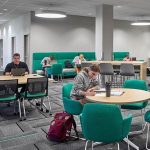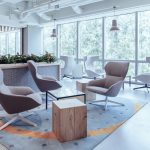Author Archives: vlm
Tips For Creating A Welcoming And Warm Healthcare Facility
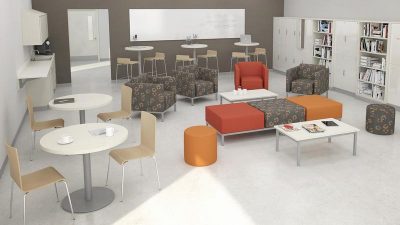
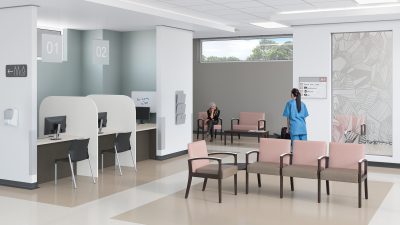 If you own or operate a healthcare facility, you know that there are probably other places your patients would rather be spending their day. If your office and waiting room environment is “too clinical”, it can affect your patients’ mood, and give them a less than stellar overall view of your facility.
If you own or operate a healthcare facility, you know that there are probably other places your patients would rather be spending their day. If your office and waiting room environment is “too clinical”, it can affect your patients’ mood, and give them a less than stellar overall view of your facility.
There are a number of things you can do to improve the look and function of your offices, waiting rooms and examination rooms, and make your healthcare facility more welcoming to your patients, often without heavy expenses. Here are just a few:
5 Tips For A Warm and Welcoming Healthcare Facility
Make enhancements to the facility. Try painting the walls in a light blue or other sort of warm color. Add some plants for a touch of nature in your office, waiting rooms and exam rooms. Natural light always helps, so try to arrange your waiting areas to offer as much light from the windows as possible. Adding nature-inspired artwork on the walls can give a more homey feel too.
Create better organization. Efficiency is vital to running a welcoming healthcare facility. Of course you want your space to feel warm, but it should also include healthy organization so that anything can be found quickly and patients are waiting as little as possible. It also helps to include clear signage and directions, so that staff and patients can easily get around the building.
 Improve the waiting area. No one wants to sit in a room and wait for their appointment, but you can make the waiting area as pleasant as possible. In addition to magazines and a television, add a coffee maker (or hot water machine for tea). Including charging stations is an excellent idea, since people naturally turn to their phones for entertainment while waiting. Be sure to make Wi-Fi access available throughout your building.
Improve the waiting area. No one wants to sit in a room and wait for their appointment, but you can make the waiting area as pleasant as possible. In addition to magazines and a television, add a coffee maker (or hot water machine for tea). Including charging stations is an excellent idea, since people naturally turn to their phones for entertainment while waiting. Be sure to make Wi-Fi access available throughout your building.
Improve the examination rooms. Make sure that your exam room furniture is comfortable and that there are privacy curtains and dividers in the examination area. As with the waiting area, you can arrange any furniture and beds for maximum efficiency and comfort.
Make your overall space encouraging. If you can, find a way to display patient testimonials or your company’s achievements. Having pictures of your employees along with their bios is a way to both assure your patients and boost your employee morale.
All of these things, in addition to an efficient arrangement of furniture, will lead to a more welcoming and warm environment for your patients and employees. It’s all part of a facility design that leads to better business.
Are you interested in redesigning your healthcare facility and creating a more welcoming environment for your patients and your employees? Reach out to the office design experts at Bellia today, and request a free workspace evaluation. We’ll be happy to share more ideas with you, and remake your facility to help you love the space you’re in!
3 Solutions to Office Noise
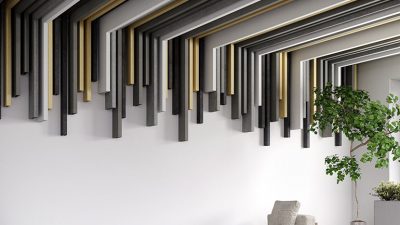
A common concern in the workplace…excessive noise. People chatting (and sometimes shouting), loud equipment being used, phones ringing, and other aural distractions can affect productivity. If you are not sure which acoustic solution is right for you, below are some answers to when and where acoustic panels are necessary, and the problems they can solve.
Acoustic Office Noise Solutions You Can Implement Now
In the office improvement space, there are ways to create a more relaxing environment and reduce noise levels…aside from creating dedicated spaces for meetings, phone conversations, etc. Here are a few solutions:
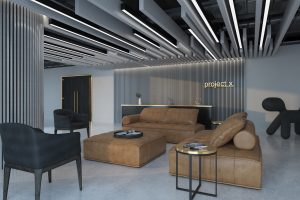 Wall and Ceiling Acoustic Panels – Acoustic panels in walls and ceilings are made from sound-absorbing materials like fiberglass or foam, which works by turning sound waves into heat and dissipating the energy. Hard surfaces in a room reflect sound energy (think of the sound volume level in a room with or without carpeting), while acoustic wall and ceiling panels reduce it. The result is a more comfortable space where noise levels are kept down.
Wall and Ceiling Acoustic Panels – Acoustic panels in walls and ceilings are made from sound-absorbing materials like fiberglass or foam, which works by turning sound waves into heat and dissipating the energy. Hard surfaces in a room reflect sound energy (think of the sound volume level in a room with or without carpeting), while acoustic wall and ceiling panels reduce it. The result is a more comfortable space where noise levels are kept down.
Acoustic panels can be designed to certain specifications, and an acoustical engineer can help to determine the acoustic needs of a room based on its size, shape and sources of sound.
Acoustical Lights – Acoustical lights are actually acoustic ceiling panels with lighting fixtures integrated within them. They are made of sound-absorbing materials, and they can be covered in a decorative fabric to match the office décor.
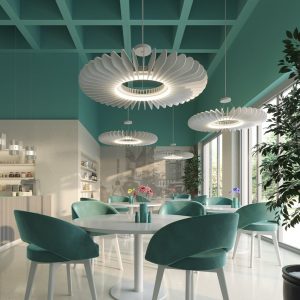 The acoustical light panels absorb the sound waves in the room, rather than reflecting and echoing them. The result is a more comfortable and quieter office environment. In addition, combining lighting and acoustic panels into one product helps to keep office improvement costs down.
The acoustical light panels absorb the sound waves in the room, rather than reflecting and echoing them. The result is a more comfortable and quieter office environment. In addition, combining lighting and acoustic panels into one product helps to keep office improvement costs down.
Sound Masking – Sound masking is the process of installing sound emitting devices strategically within an office space. These devices broadcast a low volume white noise that masks other sounds in the area. With sound masking, a company can fill an office with multiple types of white noise, such as waves, waterfalls, or even sound just like the heat/air are running, etc. for a more relaxing, private and peaceful office environment.
In addition to installing acoustic panels or sound masking equipment, offices can take other steps to help reduce the noise level in the space. Companies can create smaller spaces with reduced lighting to encourage low-volume activities, and they can take advantage of private offices that aren’t frequently used for smaller and quieter spaces as needed.
That’s just a small sampling of how acoustic panels can help be a solution to noise distractions in an office space and when and where their installation offers a solution. If your team is complaining about the increased noise level in the office these days, reach out to Bellia and ask us about noise reduction solutions! We are your dedicated office design team in Philadelphia and South Jersey, and we can help you love the space you’re in!
How To Compliment Your Company’s Brand With Office Design

If you’re considering an office redesign for your business, you should be thinking about how your company’s brand is represented. When customers, visitors, employees and prospective customers and employees visit your office, what are they seeing? Are they seeing an office that creates a visual image of your company’s values? Are visitors and daily occupants reminded of your company’s contribution to the community?
Office design or redesign is a fantastic opportunity to complement and enhance your company’s brand and image. It can be done in multiple ways, including:
Showing Your Values.
If your company places emphasis on creativity, why not reflect that in your office design? Create an office that imaginatively uses your colors, logo, slogan, and mission statement, along with collaborative spaces and modern ergonomically friendly furniture. Your office design should not only create a positive impression on visitors and customers but also serve as an inspiring and motivating space for your employees.
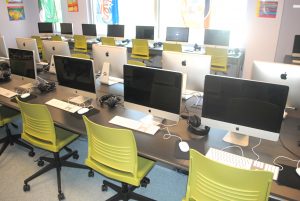
PanAmerican School, recently redesigned by Bellia and incorporating school colors and values.
Using Your Company’s Brand Colors.
Give your office space your brand’s colors, with painting, décor, graphics and other images reminding visitors about your company and what you do. Your brand colors help to create a strong visual presence and personalizes your office space.
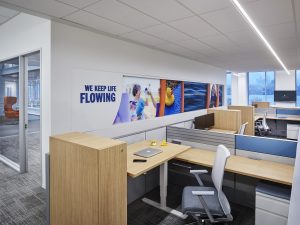
American Water HQ, recently redesigned by Bellia Office Design.
Reflect Your Community Presence.
Your modern office space should reflect your company’s place in the current environment…focusing on your sense community, teamwork, collaboration and commitment.
Employee Experience
An office redesign should also prioritize the well-being and productivity of your employees. Consider creating spaces that foster collaboration, innovation, and a positive work culture, while aligning with your brand’s aesthetic and values.
Find Out More About Reflecting Your Company’s Brand With Office Design!
At Bellia Office Design, we redesign office spaces with both efficiency and visual appeal in mind…and we can help you with an office design or redesign that makes the most of your space and with visual elements that uniquely represent your company’s brand. Reach out to us today for a free workspace evaluation and let us show you how you can love the space you’re in!
Designing Educational Spaces For Connection

The pandemic has not only changed how K-12 and higher education buildings and spaces are designed and is also drawing great attention to the fact that students thrive when they’re able to socialize and connect with others. Collaboration and social interaction have become crucial pillars in this new environment and will continue to be as the pandemic wanes.
It’s no surprise that more and more educational institutions are focusing on spaces that can support such needs. Examples of connection space needs include:
- More communal spaces for students to connect in person
- Providing easily cleanable surfaces and materials that can stand up to heavy duty cleaning
- Dedicated media and wellness spaces and accessible and inviting outdoor spaces
- Flexible multi-use floor plans and furniture layouts that support various activities and gatherings
A recent article from Haworth® (see link below) further discusses the need for students to feel like they belong. As teenagers enter adulthood, it’s important for them to feel valued and included which further increases their performance in school. As a result, collaborative spaces are being designed for connection, collaboration, and flexibility.
The Bellia team, has over 50 years of combined experience in working with k-12 and higher education facilities on a number of collaborative and open plan design projects. For educational institutions at every level, the goal is to encourage collaboration and connection in its student body, through a customized furniture solution, while providing every single individual a sense of belonging.
Are Your Ready To Design Your Connection Based Educational Space?
With our extensive experience, the Bellia team can design the perfect educational space for connection in your facility – whether starting from scratch or simply updating your existing facility’s open spaces, we’ll be with you every step of the way. Reach out to us today to request a space evaluation and get started creating new and inviting spaces for your students!
Source: https://www.haworth.com/na/en/spark/articles/2022/q1/places-where-students-feel-they-belong.html
The Office of the Future – Top 5 Design Themes

A few years following the COVID-19 lockdowns, empty offices, and a mostly remote work force, we’re finally seeing a shift in people coming back to the office. However, the office environment is not what it used to be. As demographics shift from the typical 9-to-5 schedule, the office of the future is about accommodating and caring for hybrid employees while focusing on technology, collaboration and restorative spaces.
What’s In Store For The Office of The Future?
From our firsthand experience working with our customers, we have recognized the following 5 themes which have been highlighted in a recent Haworth® article about the office of the future.
- Technology – The focus of office technology is heading towards supporting individuals performing activities in multiple spaces throughout the office. Every space will need to adapt to virtual presence as well as acoustics and data access.
- Restorative Spaces – As the day-to-day work has become more complex, there’s a greater need for opportunities and spaces for people to take a break and recover from stress and mental fatigue.
- Space Usage – There is a transition happening towards more group interaction and collaborative spaces and less individual work, which directly impacts how office spaces are designed and used.
- Collaboration – Since we’ve learned that work happens in a variety of settings, the office is now the center of connection and culture requiring more group spaces to make these connections instead of being in an assigned seat all day.
- Humanizing – Commercial spaces have become far more human, providing opportunities for personal and cultural expression as well as supporting health and safety through access to healthier foods and cleaner spaces.
These topics are crucial for employers and the future of their office, especially as younger generations place more emphasis on the working environment and office space in addition to salary and other job benefits.
At Bellia Interiors, our goal is not only to provide you with a beautiful office space, but to also understand your primary business drivers and how we can assist you in achieving your objectives from start to finish. Through a variety of services such as return on investment analysis and relocation services to customized space planning and furniture selections – we can deliver the future office you’ve been looking for.
Reach out and request your workspace evaluation today! We look forward to making your office work for you and your employees!
Sources: Haworth
Office Space Design That Is Environmentally Responsible

The professionals at Bellia are dedicated to designing office spaces for the future, and that includes office space design that is environmentally responsible. By assisting our clients with their furniture selection and office space layout, we have a direct impact on office space design and help make workplaces both healthy and sustainable. Bellia Interiors Group is a proud dealer and partner of furniture manufacturers such as Haworth® and Groupe Lacasse, who provide environmentally sustainable furniture, while staying ahead of the technology curve.
In the wake of the COVID-19 pandemic, interior designers have become more conscious of how to make the best use of space for a positive impact. In some ways, it’s a welcome opportunity to address climate and health issues, as more and more employees are opting to work remotely.
Bellia’s Environmentally Responsible Office Space Design
Our team of designers can help to improve and enhance your office environment in a number of ways:
• Future Adaptability. We can re-arrange, modify, and reconfigure your workstations and floor plate in an optimal and scalable way, so that your place of business can adapt easily to future needs…saving you both time and money in the longevity of your office design.
• Furniture Selection. Our team can help you select the right environmentally friendly products from a wide variety of furniture options, from height adjustable desks and task chairs to lounge and café furniture, that can be used in multiple settings. Your new furniture can help you achieve the results you need, while supporting a healthy and sustainable office environment.
• Partial Furniture Replacement. We offer a large selection of furniture pieces and furniture layouts that can be partially replaced without the cost and hassle of full replacement…further supporting the environment and avoiding the need for removal and extra debris in the landfills.
• Sustainable Products. Our manufacturers, such as Haworth®, Groupe Lacasse, JSI and AIS, offer a range of products that have attained environmentally friendly certifications, including Cradle to Cradle, LEED, Greenguard, BIFMA, and others.
Throughout our 49 years in the furniture design business, we’ve always been focused on the importance of design longevity for our clients, and therefore carefully select and suggest solutions that will withstand the test of time while supporting our environment inside and out.
If it’s time for you to relocate or upgrade your office, or if you need a redesign or refresh as more employees work remotely, reach out to us today or click here to request an absolutely free work and space evaluation. Now is your chance to create an office space design that is not only environmentally responsible, but is also geared towards your and your planet’s sustainable future. Bellia is here to help you love the space you’re in!
Find out more about how Bellia can improve your office space for the better…follow us on LinkedIn!
Outdoor Office Spaces are Becoming a Hot Trend

As technology enables a rapidly growing number of employees to work remotely, and as companies focus more on offices with inviting meeting spaces rather than desks and cubicles, outdoor office spaces are becoming a hot trend. In areas with comfortable climates especially, companies can take advantage of growing technology…ironically, to help people enjoy nature more as a means to becoming more effective.
This article from the Haworth blog delves into some details about the benefits of spending more time outside…and interestingly cites an article from National Geographic that explains how humans are wired to relax in natural surroundings, because that’s where our roots are as creatures.
As the article also points out, being in nature more helps our well-being in a number of ways. Being part of a natural environment enhances our cognitive function, our attention skills, and our creative problem solving skills.
As a result, companies are doing more to accommodate staff needs and desire to spend more time outside. It’s possible to create a perfectly viable outdoor meeting or working space that includes comfortable furniture and a strong Wi-Fi connection. With online meeting technology, employees can participate in meetings without having to physically attend, and can take advantage of that technology in a local café.
The article does acknowledge that it’s not always feasible to enable outdoor working spaces. But there are suggestions for companies to at least make that office environment a more pleasant, natural one, including setting up workspaces close to windows, adding plants and greenery, and changing the view to one of a more relaxing environment, with a fireplace or aquarium or other natural movement.
In today’s competitive world, companies must do everything they can to attract top talent, and enabling remote work is a great selling point. Outdoor office spaces are becoming a hot trend too, and it’s an advantage to a company looking to provide a more pleasant and optimal working environment that encourages rather than stifles creativity.
Find Out More About The Hot Trend of Outdoor Office Spaces
At Bellia Office Design, we can work with you on your office space to make it a more inviting one…whether you’d like to improve our indoor space or make use of your outdoor space. Reach out to us today and request your free workspace evaluation – we’ll help you love the space you’re in!
Anthony Bellia Featured on Entrepreneur’s Journey Podcast

Our own Anthony Bellia joins Michael Pallozzi to discuss what it’s like to be a third-generation family business owner. He discusses what it was like to grow up in a family business environment and shares what was naturally expected of him as a child as well as details of the transition process of the family business from the second to the third generation. Only 8% of family businesses make it to the third generation. In their conversation, Anthony shares several success factors that makes a family business beat the odds and last three generations.
Listen Online Now
The Future of Office Space Design
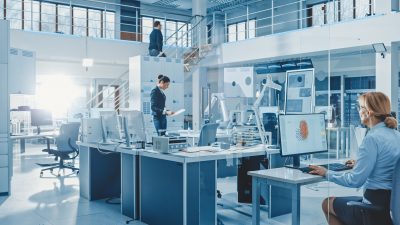
What does the future of office space design look like? It’s an interesting and sometimes difficult to answer question. With the world changing in so many ways and businesses adapting to changing needs, office design will require adaptation as well.
This article from the Haworth® blog goes into some details about five themes that will influence the future of office design: immersive technology, restorative spaces, shifting of space, increased collaboration, and increased human emphasis.
Immersive technology refers to using all of the aspects of virtual office technology to maximize the value and welcoming nature of space, including taking advantage of Internet of Things (IoT) technology.
Restorative spaces are places where employees can unplug and take a break from the flow of the workday. In the future, this will be seen as increasing in importance, especially as there is greater demand for restoration for employees.
Space shift refers to the replacing individual work stations with more spacious, flexible group spaces. As more employees have the ability to work anywhere, group collaboration will become more of an office space priority.
Increased collaboration means, in addition to more space for group interaction, that office spaces will focus on connections and culture among the employees.
Increased human emphasis means a greater focus on hospitable and welcoming office spaces, and employers placing focus on employee health for greater productivity.
In summary, the future of office space design is likely to be focused on the advantages of remote working ability, and using the opportunity to create a more welcoming space for employees and enhance group collaboration. As companies move into the 2020s, it is likely that we’ll see a whole new atmosphere in the workspace.
Ask Us About YOUR Future Office Space Design
If you’re interested in taking advantage of your office space and how you can make the most of your office collaboration in the future, reach out to Bellia Office Design! We can help you maximize your space, take advantage of new technology, and create an office that you and your employees will love. Click here for your free workspace evaluation today!
New Trends in Healthcare Facility Design
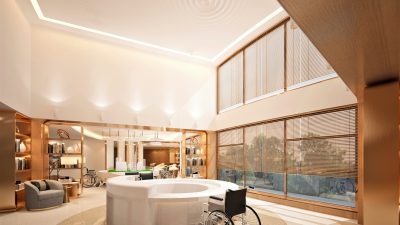
As the world adapts to creating a cleaner and healthier environment, one part of the ongoing process is new trends in healthcare facility design. As it turns out, office and interior designers can have a greater impact on the environment than they probably realize, and the design of a new or existing healthcare facility can make a world of difference in its carbon emissions.
This article from our friends at the Haworth® company goes into some details about ways that healthcare facilities can become more efficient and reduce their carbon footprint through building arrangement and design. Probably the most key factor is the ability for both employees to work remotely, and for patients and doctors to conduct virtual appointments…reducing the need for excessive facility space.
The article stresses three strategies when it comes to building a facility: build nothing, build less, or build clever.
Building nothing means taking advantage of the ever-improving ability for employees to work remotely, and repurposing existing structures as specialists’ offices, outpatient service areas, or outright leasing. The result is no new construction, which often results in waste.
Building less means maximizing available space and reducing the need for excessive space. As the need for outpatient services continually declines, a facility can make more effective use of its existing space without having to put an addition on the property.
Building clever means anticipating the need for changes in services in the future. Designers can create areas and offices that are easily adaptable to changing environments, such as through modular construction and thoughtful placement of elements like entrances and trash receptacles.
These ideas and more are helping healthcare facilities not just reduce their environmental impact, but also to make the most cost-effective use of their costly space.
Find Out More About New Trends In Healthcare Facility Design!
Reach out to Bellia today if you’d like to find out more about how we can design or redesign your healthcare office and work facility. We can help you create an environment that maximizes your space, improves your productivity, and reduces your carbon footprint. Let us help you love the space you’re in!


